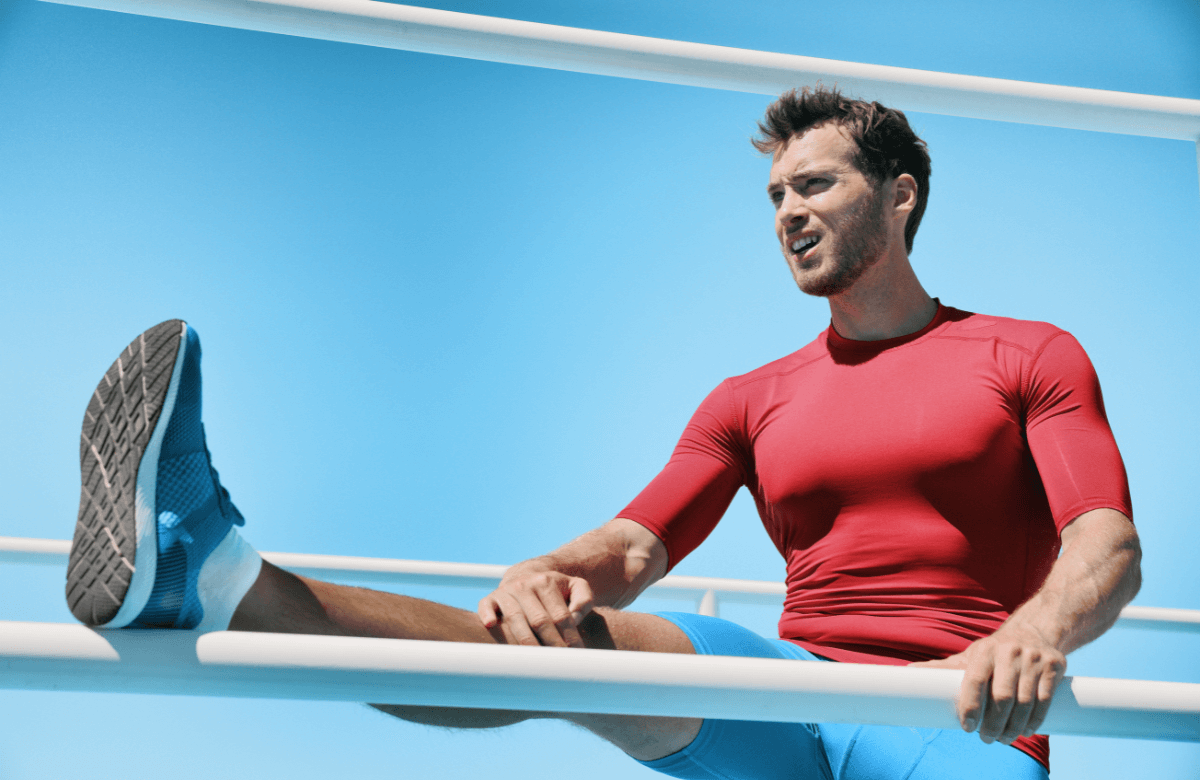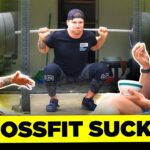The hamstrings are responsible for hip extension and knee flexion, making them vital muscles for any athletic movement that requires the lower body, like walking, running, and jumping. Because of the hamstring’s position in the back of the leg, they can often fall second to training on leg-day workouts to the quadriceps. Taking time to learn how to target the hamstrings will benefit our range of motion and overall health.
Jump to:
Where Are Your Hamstring Muscles?
The hamstrings are a group of three muscles located at the back of the thigh. They create a fulcrum with the quadriceps at the pelvis and extend down to the knee joint. The hamstring tendons interconnect the pelvis, knee, and lower leg.

Why Is It So Important to Work Your Hamstrings?
The hamstrings are a key component of the posterior chain—a group of powerful muscles that, when strengthened, can improve physical performance and decrease the risk of hamstring injuries, which are the most common injuries among athletes.
Adding hamstring training to your workouts, along with proper recovery care, will not only help you avoid injuries and pain, but will also help with increased mobility, speed, flexibility, and overall strength.
Best Hamstring Workouts with Weights
Weight training is a great way to build up both muscle size and strength in the hamstrings, and typically yields quicker results than training without weights. As hamstring strength increases, you can add more resistance and heavier weights. As with any workout, having good form is crucial in avoiding injury.
1. Classic Barbell Deadlift
Step up to the barbell with feet shoulder-width apart, shins close to the bar, and your toes pointing straight ahead and peeking out from beneath the bar. Keeping your core tight and a straight spine, squat down to the bar with a slight bend in the knees. Your hips should be beneath your shoulders when you perform deadlifts.
Using an overhand grip, exhale as you lift the bar, pushing upward with the legs from the knees. The bar should almost graze the shins as you extend upward to rest the bar at thigh level as you return to a standing position. Then, lower the bar back to the floor while keeping your back straight.
When performing the movement, you shouldn’t bend your arms or back, which allows your legs to do all the lifting. The shoulders should be pulled back and the glutes activated.
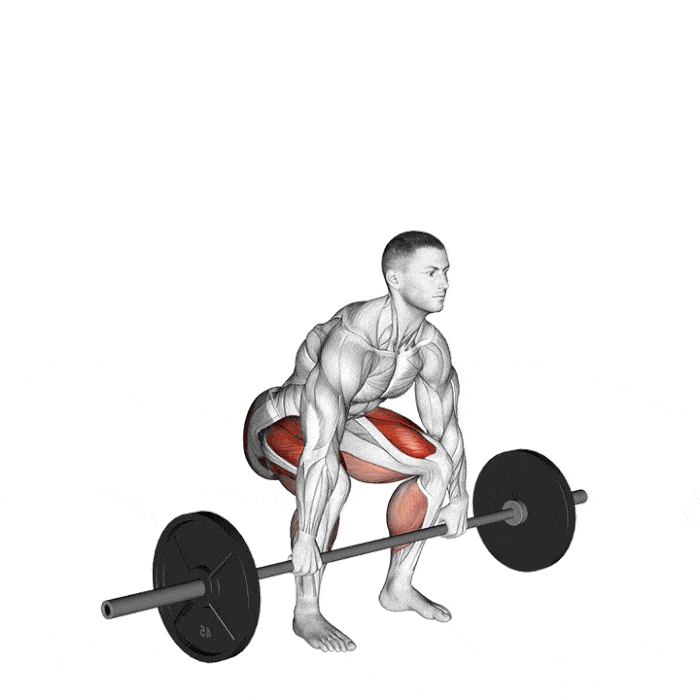
2. Good Mornings
Good mornings are a compound move that involves standing with the feet shoulder-width apart, the knees slightly bent, and the barbell resting on the upper back. Keeping a tight core and pushing through your glutes, hinge forward at the hip until your torso is nearly parallel with the floor. You should feel a nice stretch in your hamstrings.
Return to standing by thrusting your hips forward in an explosive movement, squeezing through your hamstrings and glutes. You can perform good mornings with or without weights.

3. Barbell Hip Thrust
Begin this exercise seated on the floor with feet flat on the ground and slightly wider than hip-distance apart. Bend your knees with your upper back resting against the edge of a weight bench. Place the weight bar across the hips.
During the hip thrust, lift by driving through your heels and squeezing the glute muscles. Check that your ankles are right below your knees and your hips are level with your shoulders. Keep your core tight and your chin tucked as you slowly lower the bar until your hips are right above the floor. Squeeze the glutes and repeat.
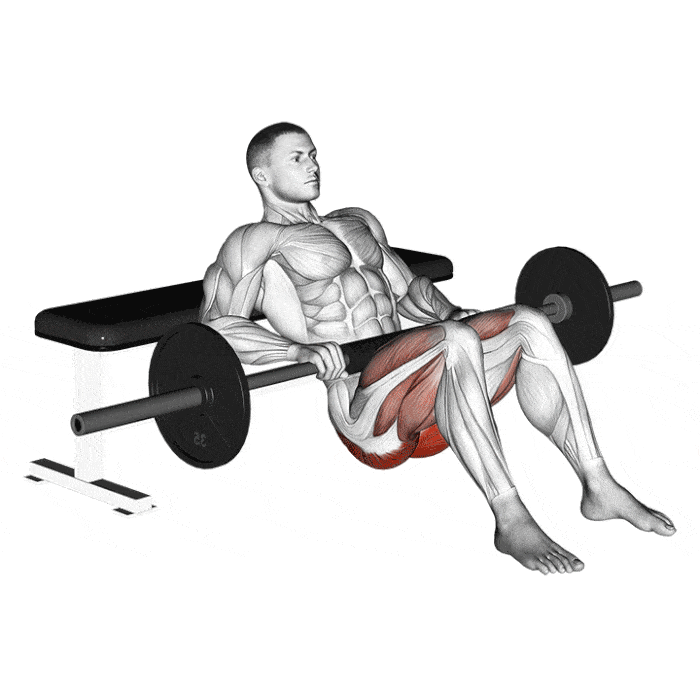
4. Romanian Deadlift
The Romanian deadlift differs from the conventional deadlift because you don’t squat. You’ll have stiffer legs and a soft knee bend.
To perform the Romanian deadlift, start by standing tall with your feet underneath your hips. Grip the barbell with both hands and hold it in front of your mid-thigh. Keeping your back flat, hinge at the hip until your backside is positioned behind your heels.
Lower the weight beneath your knees, stopping near the middle of the shin, depending on flexibility. Tighten your hamstrings, glutes, and core while driving your feet into the ground to stand up straight in an explosive motion, bringing the barbell back to the mid-thigh. Squeeze your glute muscles at the top.
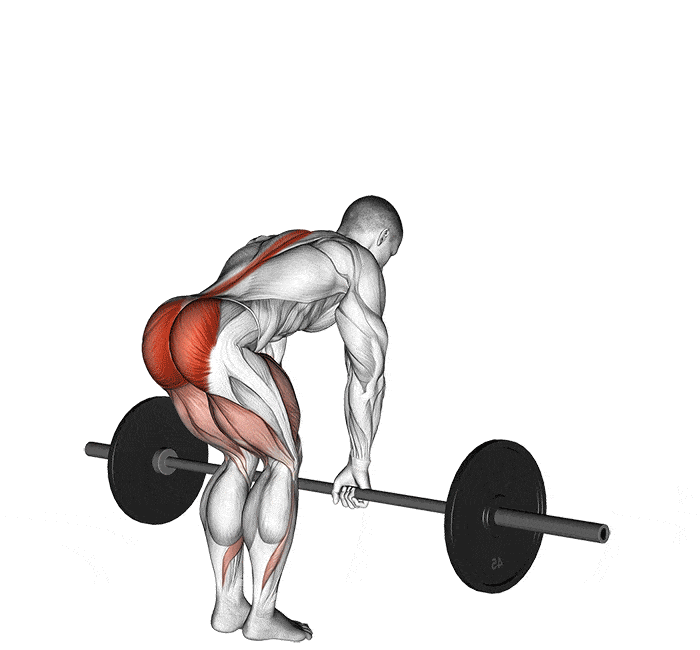
5. Kettlebell Swing
A good thing to keep in mind before doing a kettlebell swing is that this is a dynamic movement. While the kettlebell descends, gravity makes the overall weight of the kettlebell feel much heavier at the bottom of the swing, so choose the weight of the kettlebell accordingly.
Begin a kettlebell swing by planting both feet flat on the ground, shoulder-width apart. Hold the kettlebell with both hands, palms facing down. Inhale, hinge your hips, and with an engaged core, push your kettlebell between the legs.
On the inhale, contract your glutes and raise your arms to shoulder height as you come into a standing position. Complete the rep by inhaling, softly bending the knees, and swinging the kettlebell back down between your knees.
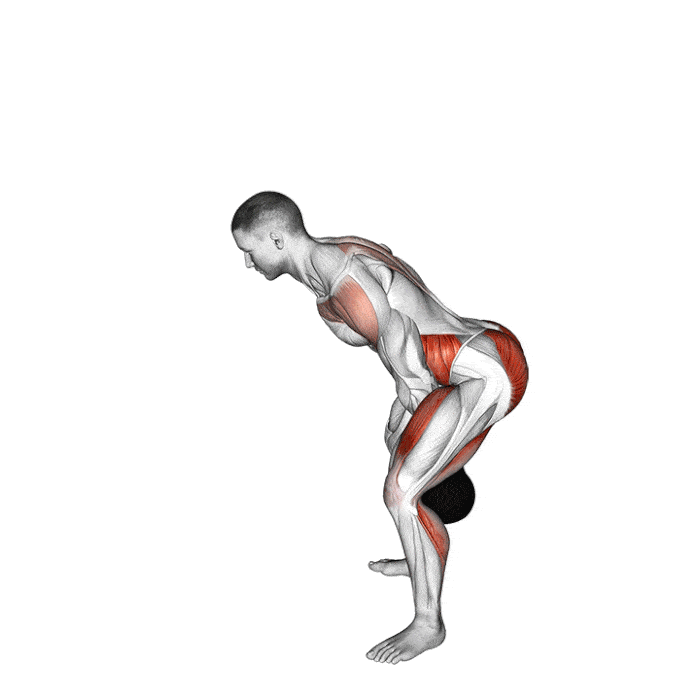
Best Bodyweight Hamstring Workouts
Not only can bodyweight hamstring workouts help with stability and endurance, but it’s also a great way to reduce the injury risk that comes with heavy weightlifting. Another benefit of bodyweight workouts is that there’s no equipment required, making it easy to do these exercises anywhere at any time! Bodyweight workouts can also be dually beneficial as they can combine cardio and strength training with workouts.
6. Glute Bridge
Lay down on your back with your knees bent and your feet flat on the floor. You can ensure that your feet are in the correct position for the glute bridge if your fingertips can graze the back of the heel when you reach down. Press your lower back into the ground to engage your core.
Squeeze your glutes and ab muscles and raise without arching your back. Your body should be in a parallel line from your knees to your shoulders. Hold this position for two seconds before lowering back down, keeping your chest open with your glutes and core engaged.
7. Lateral Lunge
Start in the standing position with your feet shoulder-width apart. Take a large step with the left leg, bending at the left knee to a 90-degree angle while maintaining a flat back. Push off the ground with your left foot and come back to a standing position. Alternate between the right and left leg.
8. Split Squat
Stand with your body in a staggered stance with your right foot forward and your left foot back. Bend both knees until they are at a 90-degree angle. Then quickly propel both feet off of the floor, bringing your left foot in front of you with the right food behind during the whole split squat exercise.
9. Reverse Plank
Begin by sitting in an upright position with your legs extended in front of you. Place your hands behind your body and lift your hips and torso towards the ceiling with your toes pointed. Your body should form a straight line from your head to your toes. Hold this position for 20-30 seconds before lowering your hips and torso back to starting position.

10. The Glute Bridge and Curl
This glute bridge variation is especially beneficial for the hamstring muscles. You have the option of doing a single-leg bridge and curl or the more advanced two-leg bridge and curl. To do this exercise, place a towel or sliders under one or both feet and get into position to do a glute bridge. Once your hips are raised, extend one leg out at a time (both legs if you’re doing a two-leg bridge and curl). Push through the heel to come back into a glute bridge position.
Best Hamstring Workouts with Machines and Equipment
Having access to workout machines and equipment can be very beneficial in safely strengthening the hamstrings as it regulates the appropriate range of motion for each exercise movement. You are less likely to become injured by dropping weight or overextending your joints while using a machine. It can also help perfect form.
11. Lying Leg Curl
Adjust the machine to cater to your height. Lie face down on the machine with your knees locked and your heels shoulder-width apart under the rolls. If you’ve adjusted the machine appropriately for the leg curls, your knees should slightly hang off the bench with your legs fully extended. Starting position will have you holding the handles for support and pressing your torso and thighs against the bench. As you inhale, use your hamstrings to curl your legs to lift the weight as high as possible. Hold this position for a moment before lowering the legs back to starting position.

12. Swiss-Ball Leg Curl
Similar to the glute bridge and curl, this glute bridge variation uses a Swiss ball. It’s a compound exercise that requires additional core stabilization.
Begin by lying flat on the floor and placing the heels shoulder-width apart on the Swiss ball with the knees bent at 90 degrees. With your hands at your side, lift the hips and while squeezing the glutes, extend the legs out in front of you. Keep the hips raised and focus on keeping the ball stable as you curl your legs back close to your body. Squeeze the abs as you extend your legs back to the starting position.

13. Banded Hamstring Curl
Anchor your resistance band to a pole and sit on a bench or chair with both feet inside of the band. You should be far enough away that you feel some tension when you extend your legs. Sit straight up with your core engaged. Pull the heels slowly back into the glutes before extending them straight out in front of you to complete the rep.
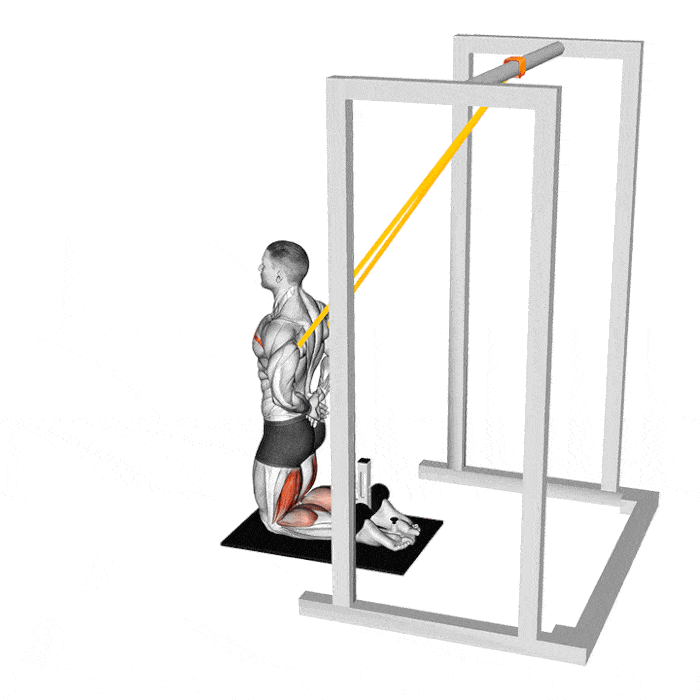
14. Seated Leg Curl
Adjust the height of the leg curl machine and set your weight stack to your preferred weight. Extend the legs hip-width apart on top of the pad, positioning it to come right above your ankle with your toes pointed up. Pull the top pad down so it sits snugly on top of your thighs.
Sit back and pull the heels down, squeezing the glutes at the bottom, and then slowly extend the legs up as far as you can.
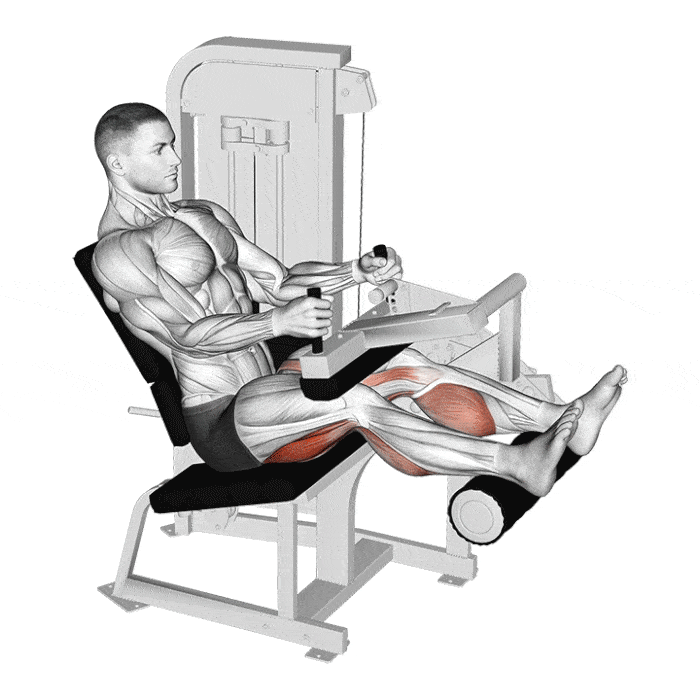
15. Leg Press with Machine
Adjust the seat on the leg press machine so you’re far enough away to get a good extension when you press against the platform. Select the desired amount of weight on the cable-rigged weight stack. Sit with your back and head against the seat and your feet planted shoulder-width apart in the center of the platform. Push through your feet to fully extend the leg, take a beat, and then slowly, with control, bend the knees to return the platform to the starting position.
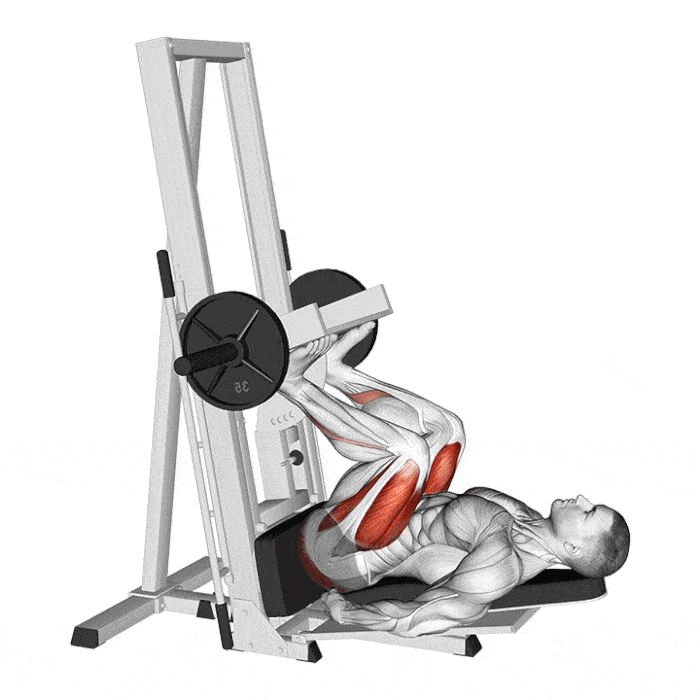
Best Hamstring Stretches Pre and Post Workout
Stretching is absolutely vital in maintaining healthy muscles. Stretching before you exercise can enhance your workout as it increases flexibility and your range of motion. Stretching after a workout helps reduce the lactic acid in the muscle, which causes muscle soreness, and helps alleviate stiff and tense muscles.
Inchworms
This is a fantastic stretch for the posterior chain—and a great active warm-up to precede leg workouts. Begin by standing tall, with your feet hip-width apart and your core engaged. Pay special attention to your posture. Your shoulders, hips, and knees should create a straight line.
Exhale as you reach to the ground with your hands, walking them in front of you as you bend forward, rolling down one vertebra at a time. Depending on flexibility, your legs may bend so you can reach the ground. Your heels will lift off of the floor as you get closer to full plank position.
Once your hands are directly under your shoulders, your body should be in a flexed position. Slowly walk your feet up to your hands to get a nice stretch in the hamstrings. Once your feet are as close to your hands as they can be, slowly roll your torso back into a standing position, one vertebra at a time.
Foam Rolling
Foam rolling after a workout is beneficial as it can help break up scar tissue, increase blood flow and oxygen to the body muscles, and reduce soreness and muscle pain by decreasing the production of lactic acid.
To foam roll the hamstrings, begin by sitting with your legs in front of you and the foam roller placed under your thighs. With your hands behind you, lift the glutes and allow the roller to roll along your thighs from your knees to your buttocks.
Forward Fold
The forward fold is not only a good stretch for the hamstrings, but it also strengthens the hip flexors. Incorporating the forward fold can help alleviate back pain and tightness and stretch your hip muscles after a long day of sitting at a desk.
To do the forward fold, stand with your feet planted flat on the ground and shoulder-distance apart. Take a deep breath in as you raise both of your hands above your head, and exhale as you glide your arms out to your side and hinge at the hip.
Keep your back straight and the back of your neck long, looking at the floor in front of you. Continue folding down from the hips as you try to keep your spine as long as possible. Bring your hands down in front of your feet or on yoga blocks, depending on your flexibility. When you’re ready to come back up, bend at the knees and reach your arms up over your head.
Hurdler Stretch
The hurdler stretch uses your upper-body weight to give the hamstrings a deep stretch.
Start in a sitting position with your legs in front of you. Bend your right knee so that it’s curled up in front of your groin. Lean forward over the right leg and reach your arms straight out onto the floor while you bend the left knee and angle it behind you.
Hold for 20-30 seconds and repeat on the opposite leg.
Straight Leg Lean Forward
Perhaps the most classic hamstring stretch, the straight leg lean forward is done by sitting on the floor with your legs straight out in front of you. As flexibility allows, bend at the hip and reach towards the feet while keeping your legs as straight as possible.

FAQs About Hamstring Workouts
Let’s just clear up any remaining questions you might have about working your hamstrings. Here are the questions we see most often asked.
What’s the Best Overall Exercise to Build Hamstrings?
If you want to strengthen your hamstring muscles, incorporating a single-leg deadlift into your exercise routine is a must! This athletic movement requires balance and stability. Over time, it’ll support better hamstring engagement, thus benefiting the overall strength and power of not only the posterior chain but also the upper body.
Before doing the single-leg deadlift, choose your weight. A traditional deadlift usually calls for heavy weights, but as the single-leg deadlift works on one leg at a time, it’s in a hypertrophy training zone. Choosing a lighter weight satisfies the goal of improving balance and building muscles.
To do a single-leg deadlift, begin in a standing position, with your right leg planted in front of you and a slight bend in the knee. Hold your weight in the left hand and hinge slowly from the hip joint as you extend the left leg behind you, keeping your toe pointed toward the ground. Keep a flat back and a neutral neck as you lower the weight down to the ground, then rise into a standing position. Repeat on the opposite side.
Do Regular Squats Work Hamstrings?
While the squat is a great exercise to develop the quads and glutes, it’s not effective in building hamstring strength. A traditional squat only minimally engages the hamstrings, but the exercises listed above are much more beneficial for building up the hamstring muscles.
Should I Train My Hamstrings Every Day?
Properly training your hamstrings causes muscle fatigue, so recovery is crucial as it allows those muscles to repair, rebuild, and ultimately become stronger. Training your hamstrings 2-3 times a week is sufficient and helps avoid excessive muscle fatigue.
What Workout Machines Hit Hamstrings?
Most gyms are equipped with multiple machines that help build hamstring strength. Here are a few popular options:
-The Leg Press Machine
-The Seated Leg Curl
-The Lying Leg Curl
-The Standing Leg Curl
-Smith Machine Stiff-leg Deadlift
–Smith Machine Romanian-Deadlift
Should Hamstrings Be High or Low Reps?
The hamstrings are considered fast twitch, meaning they contract quickly to help you perform high-intensity workouts for a short period (think sprinting). So, lower reps are the most effective way to build them up. Use a heavy resistance and keep the reps below 10.
How Long Until You Notice Hamstring Growth?
Unlike Amazon Prime, building strong muscles doesn’t come in two days. It takes patience, but consistent hamstring training 2-3 times a week over 8 weeks will yield results. Remember that adding variety to your training and allowing 48 hours of recovery between sessions will help you in your journey to stronger and more powerful hamstrings.


